小学六年级英语上第六单元导学案
- 格式:doc
- 大小:501.00 KB
- 文档页数:10
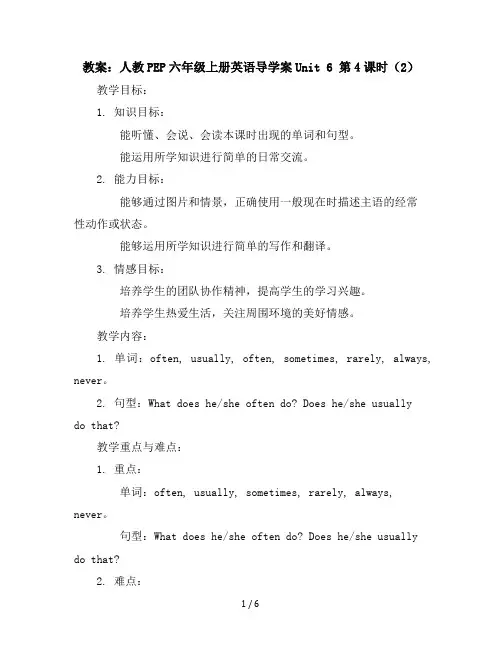
教案:人教PEP六年级上册英语导学案Unit 6 第4课时(2)教学目标:1. 知识目标:能听懂、会说、会读本课时出现的单词和句型。
能运用所学知识进行简单的日常交流。
2. 能力目标:能够通过图片和情景,正确使用一般现在时描述主语的经常性动作或状态。
能够运用所学知识进行简单的写作和翻译。
3. 情感目标:培养学生的团队协作精神,提高学生的学习兴趣。
培养学生热爱生活,关注周围环境的美好情感。
教学内容:1. 单词:often, usually, often, sometimes, rarely, always, never。
2. 句型:What does he/she often do? Does he/she usuallydo that?教学重点与难点:1. 重点:单词:often, usually, sometimes, rarely, always, never。
句型:What does he/she often do? Does he/she usuallydo that?2. 难点:一般现在时的运用。
正确使用频率副词。
教具与学具准备:1. 教具:PPT、图片、卡片。
2. 学具:笔记本、文具盒、课本。
教学过程:1. 热身(5分钟)跟唱歌曲 "What do you usually do?"。
老师出示日常活动图片,学生用中文描述。
2. 导入(10分钟)老师出示一张自己的课程表,引导学生用中文描述老师的日常活动。
学生分组,每组设计一个课程表,并用中文描述。
3. 新课呈现(15分钟)老师出示一张图片,引导学生用英文描述图片中人物的日常活动。
学生听录音,跟读新单词和句型。
4. 课堂练习(10分钟)学生分组,每组设计一个情景,用英文描述。
每组选一名代表进行角色扮演。
5. 巩固练习(5分钟)老师出示一张图片,学生用英文描述图片中人物的日常活动。
学生互相提问,用英文回答。
板书设计:1. 单词:often, usually, sometimes, rarely, always, never。
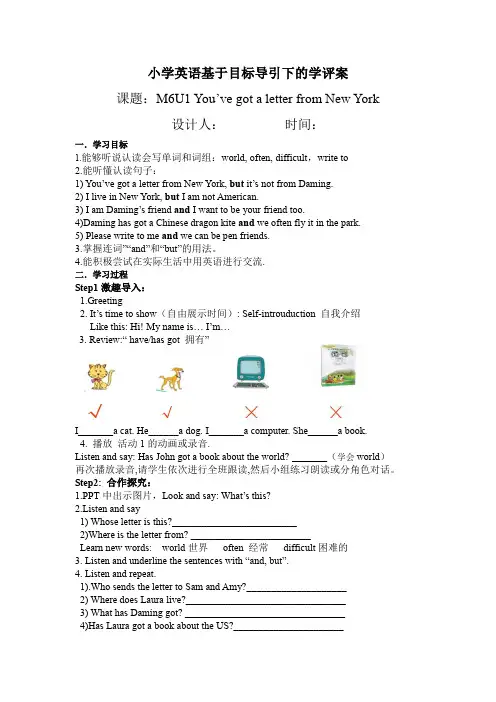
小学英语基于目标导引下的学评案课题:M6U1 You’ve got a letter from New York设计人:时间:一.学习目标1.能够听说认读会写单词和词组:world, often, difficult,write to2.能听懂认读句子:1) You’ve got a letter from New York, but it’s not from Daming.2) I live in New York, but I am not American.3) I am Daming’s friend and I want to be your friend too.4)Daming has got a Chinese dragon kite and we often fly it in the park.5) Please write to me and we can be pen friends.3.掌握连词”“and”和“but”的用法。
4.能积极尝试在实际生活中用英语进行交流.二.学习过程Step1激趣导入:1.Greeting2. It’s time to show(自由展示时间): Self-introuduction 自我介绍Like this: Hi! My name is… I’m…3. Review:“ have/has got 拥有”I_______a cat. He______a dog. I_______a computer. She______a book.4. 播放活动1的动画或录音.Listen and say: Has John got a book about the world? _______(学会world)再次播放录音,请学生依次进行全班跟读,然后小组练习朗读或分角色对话。
Step2: 合作探究:1.PPT中出示图片,Look and say: W hat’s this?2.Listen and say1) Whose letter is this?_________________________2)Where is the letter from? ________________________Learn new words: world世界often 经常difficult困难的3. Listen and underline the sentences with “and, but”.4. Listen and repeat.1).Who sends the letter to Sam and Amy?____________________2) Where does Laura live?________________________________3) What has Daming got? ________________________________4)Has Laura got a book about the US?______________________语法小常识1、并列句:两个或两个以上的简单句用and 或者but连在一起,就构成了并列句。
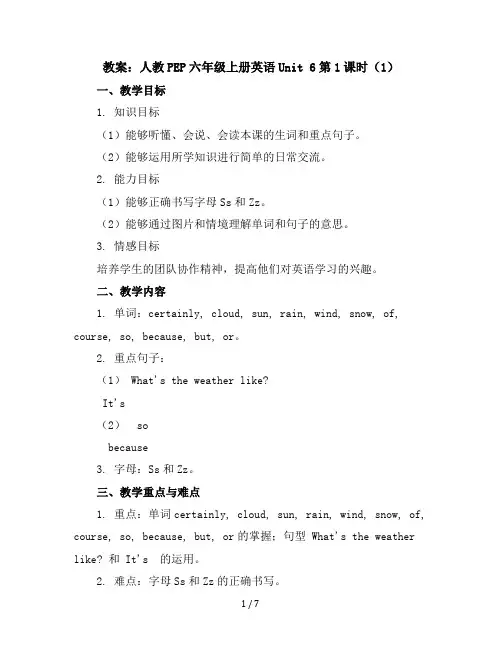
教案:人教PEP六年级上册英语Unit 6第1课时(1)一、教学目标1. 知识目标(1)能够听懂、会说、会读本课的生词和重点句子。
(2)能够运用所学知识进行简单的日常交流。
2. 能力目标(1)能够正确书写字母Ss和Zz。
(2)能够通过图片和情境理解单词和句子的意思。
3. 情感目标培养学生的团队协作精神,提高他们对英语学习的兴趣。
二、教学内容1. 单词:certainly, cloud, sun, rain, wind, snow, of, course, so, because, but, or。
2. 重点句子:(1) What's the weather like?It's(2) sobecause3. 字母:Ss和Zz。
三、教学重点与难点1. 重点:单词certainly, cloud, sun, rain, wind, snow, of, course, so, because, but, or的掌握;句型 What's the weather like? 和 It's 的运用。
2. 难点:字母Ss和Zz的正确书写。
四、教具与学具准备1. 教具:PPT、黑板、粉笔。
2. 学具:课本、练习册、铅笔、橡皮。
五、教学过程1. 导入(1)复习上一单元的单词和句子。
(2)引导学生谈论天气,引出本课内容。
2. 新课呈现(1)展示PPT,呈现本课的生词和句子。
(2)讲解生词和句子的意思,让学生跟读。
3. 课堂练习(1)让学生分组,进行角色扮演,运用本课的单词和句子进行对话。
(2)挑选几组学生进行表演,给予评价。
4. 书写练习(1)讲解字母Ss和Zz的书写方法。
(2)让学生在练习册上书写字母Ss和Zz,教师巡视指导。
5. 课堂小结六、板书设计1. 生词:certainly, cloud, sun, rain, wind, snow, of, course, so, because, but, or。
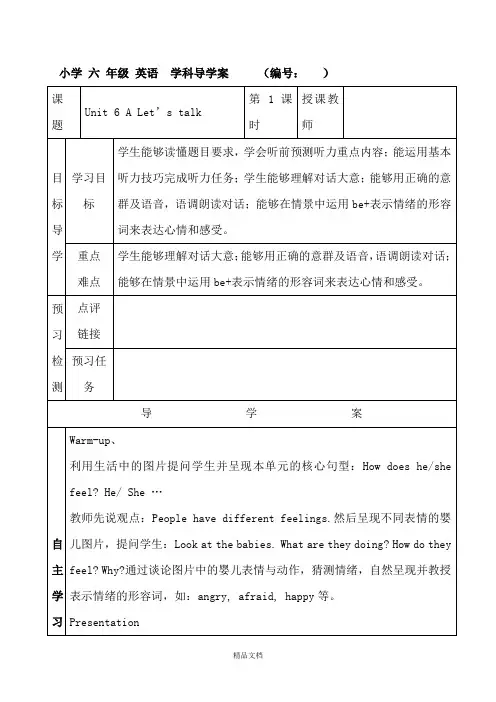
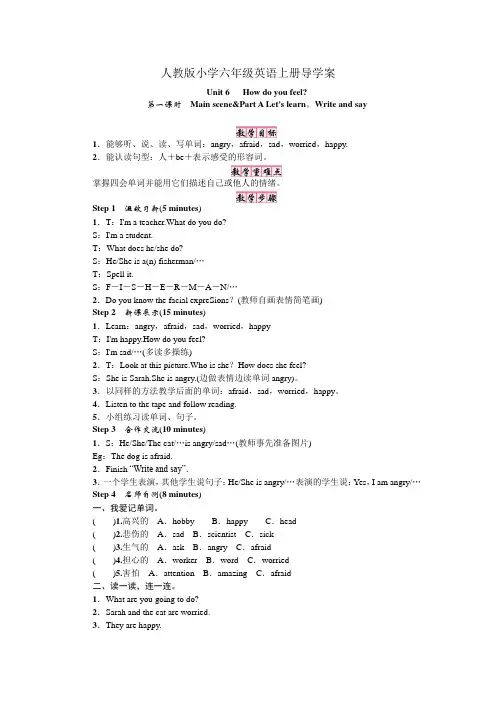
人教版小学六年级英语上册导学案Unit 6How do you feel?第一课时Main scene&Part A Let's learn,Write and say1.能够听、说、读、写单词:angry,afraid,sad,worried,happy.2.能认读句型:人+be+表示感受的形容词。
掌握四会单词并能用它们描述自己或他人的情绪。
Step 1温故习新(5 minutes)1.T:I'm a teacher.What do you do?S:I'm a student.T:What does he/she do?S:He/She is a(n) fisherman/…T:Spell it.S:F-I-S-H-E-R-M-A-N/…2.Do you know the facial expreSions?(教师自画表情简笔画)Step 2新课展示(15 minutes)1.Learn:angry,afraid,sad,worried,happyT:I'm happy.How do you feel?S:I'm sad/…(多读多操练)2.T:Look at this picture.Who is she?How does she feel?S:She is Sarah.She is angry.(边做表情边读单词angry)。
3.以同样的方法教学后面的单词:afraid,sad,worried,happy。
4.Listen to the tape and follow reading.5.小组练习读单词、句子。
Step 3合作交流(10 minutes)1.S:He/She/The cat/…is angry/sad…(教师事先准备图片)Eg:The dog is afraid.2.Finish “Write and say”.3.一个学生表演,其他学生说句子:He/She is angry/…表演的学生说:Yes,I am angry/…Step 4名师自测(8 minutes)一、我爱记单词。
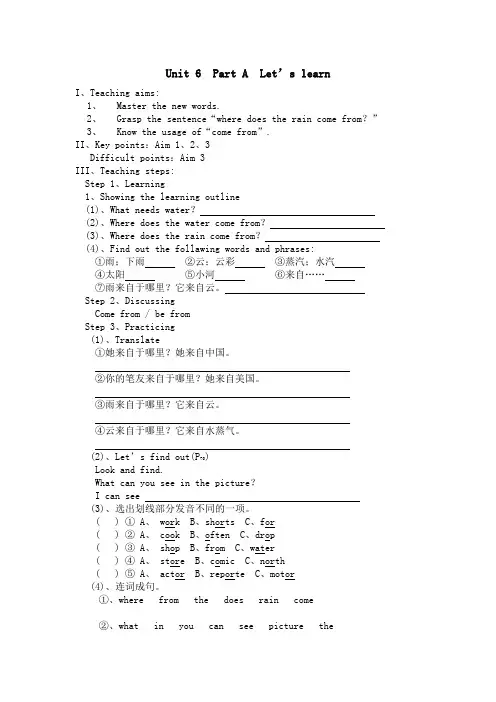
Unit 6 Part A Let’s learnI、Teaching aims:1、Master the new words.2、Grasp the sentence“where does the rain come from?”3、Know the usage of“come from”.II、Key points:Aim 1、2、3Difficult points:Aim 3III、Teaching steps:Step 1、Learning1、Showing the learning outline(1)、What needs water?(2)、Where does the water come from?(3)、Where does the rain come from?(4)、Find out the follawing words and phrases:①雨;下雨②云;云彩③蒸汽;水汽④太阳⑤小河⑥来自……⑦雨来自于哪里?它来自云。
Step 2、DiscussingCome from / be fromStep 3、Practicing(1)、Translate①她来自于哪里?她来自中国。
②你的笔友来自于哪里?她来自美国。
③雨来自于哪里?它来自云。
④云来自于哪里?它来自水蒸气。
(2)、Let’s find out(P70)Look and find.What can you see in the picture?I can see(3)、选出划线部分发音不同的一项。
( ) ① A、 work B、shorts C、for( ) ② A、 cook B、often C、drop( ) ③ A、 shop B、from C、water( ) ④ A、 store B、comic C、north( ) ⑤ A、 actor B、reporte C、motor(4)、连词成句。
①、where from the does rain come②、what in you can see picture the(5)、单选。
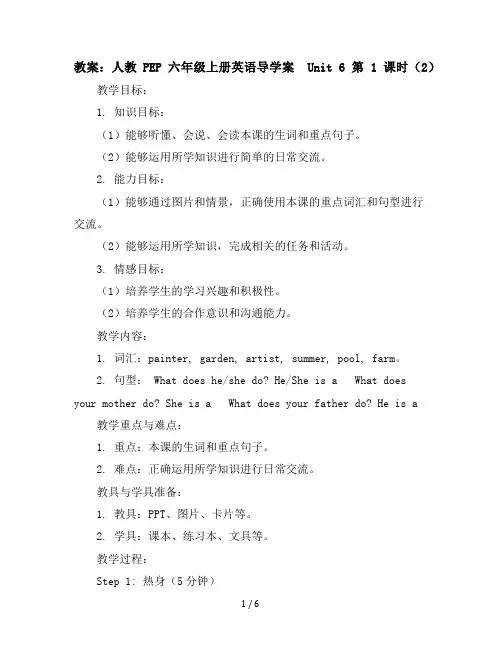
教案:人教PEP 六年级上册英语导学案 Unit 6 第 1 课时(2)教学目标:1. 知识目标:(1)能够听懂、会说、会读本课的生词和重点句子。
(2)能够运用所学知识进行简单的日常交流。
2. 能力目标:(1)能够通过图片和情景,正确使用本课的重点词汇和句型进行交流。
(2)能够运用所学知识,完成相关的任务和活动。
3. 情感目标:(1)培养学生的学习兴趣和积极性。
(2)培养学生的合作意识和沟通能力。
教学内容:1. 词汇:painter, garden, artist, summer, pool, farm。
2. 句型: What does he/she do? He/She is a What doesyour mother do? She is a What does your father do? He is a 教学重点与难点:1. 重点:本课的生词和重点句子。
2. 难点:正确运用所学知识进行日常交流。
教具与学具准备:1. 教具:PPT、图片、卡片等。
2. 学具:课本、练习本、文具等。
教学过程:Step 1: 热身(5分钟)1. 跟唱歌曲 "Hello, Hello, Hello!"。
2. 老师出示各种职业的图片,让学生用中文进行描述。
Step 2: 引入(10分钟)1. 老师出示本课的生词和句子,让学生进行预习。
2. 学生自主学习,尝试理解生词和句子的意思。
Step 3: 课堂讲解(15分钟)1. 老师讲解生词和句子的意思。
2. 学生跟随老师一起朗读生词和句子。
Step 4: 课堂练习(10分钟)1. 老师出示各种职业的图片,让学生用英文进行描述。
2. 学生分组进行练习,互相交流。
Step 5: 课堂活动(10分钟)1. 老师分组,每组选一名画家,其他学生用英文描述画家的特点。
2. 学生进行活动,互相交流。
2. 布置作业:用英文写一篇关于自己家人的职业介绍。
板书设计:1. 生词:painter, garden, artist, summer, pool, farm。
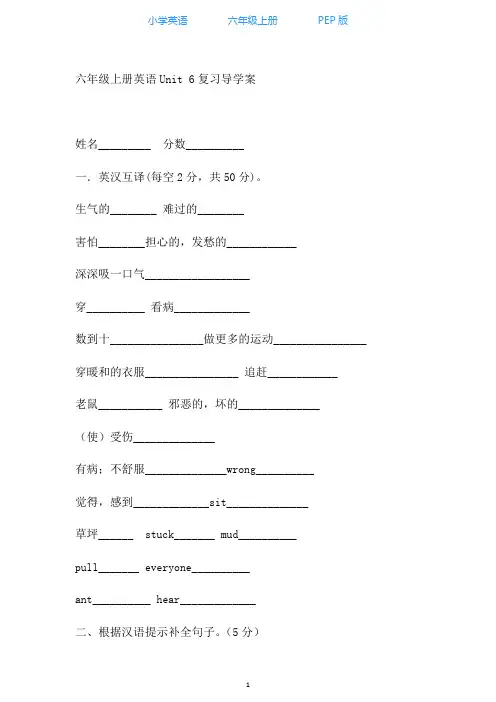
六年级上册英语Unit 6复习导学案姓名_________ 分数__________一.英汉互译(每空2分,共50分)。
生气的________ 难过的________害怕________担心的,发愁的____________深深吸一口气__________________穿__________ 看病_____________数到十________________做更多的运动________________ 穿暖和的衣服________________ 追赶____________老鼠___________ 邪恶的,坏的______________(使)受伤______________有病;不舒服______________wrong__________觉得,感到_____________sit______________草坪______ stuck_______ mud__________pull_______ everyone__________ant__________ hear_____________二、根据汉语提示补全句子。
(5分)1. If you are ill, you should __________________________. (看医生)2. If you want to be strong, you should ________________________. (做更多的炼)3. If you feel cold, you should ____________________________. (穿暖和的衣服) 。
4. If you are angry, you should ______________________(深吸一口气)and _______________. (数到十)三、阅读短文,选择正确答案。
(5分)I am a schoolboy. I have lessons from Monday to Friday. On Sunday morning, I usually get up very late. I wash my face and then go out to do morning exercises. It is about nine o'clock. After I eat my breakfast. I often go to the park with my parents. The park is not far (远) from our home, so we go there by bike. It takes us about ten minutes to get there by bike. There are many people in the park. They are men and women, old and young. Parents must look after their children. There is a big lake in the middle of the park. Some children are swimming, some are boating with their parents. I like boating very much. I want to boat, too. My parents buy three tickets. We have a good time there. How happy we are!( )1.I have lessons ______days a week.A. fourB.fiveC. sixD. seven( )2. I often ______ on Sundays.A. go to schoolB. get up earlyC. get up lateD. go to bed late( )3. On Sundays, there are _______ people in the park.A. muchB.very muchC.a littleD.lots of( )4. I like ______ very much.A.playing basketballB.boatsC.swimmingD.boating( )5. I 'm boating in the park with my ______.A.good friendsB.father and motherC.classmatesD.teachers四、作文写一段话,描述一下,你自己和周围人的不同的心情(不少于5句话)_________________________________________________________________PEP小学英语六年级上册重点单词和句型练习一、重点单词Unit 1:by ( ) foot( ) bike( ) bus( ) train( ) how( )go to school() traffic()traffic light()traffic rule()stop()wait() get to()Unit 2library( ) post office( ) hospital( ) cinema( ) turn( ) bookstore( ) where( ) please( )next to( ) right ( ) left( ) straight( )then ( )Unit 3next week( ) this morning( ) this afternoon( )this evening ( ) comic book( ) post card( )newspaper( ) buy( )Unit 4hobby( ) ride a bike--riding a bike( ) dive--diving( )play the violin—playing the violin( ) make kites—making kites( ) collect stamps—collecting stamps( ) live –lives( ) teach--teaches( ) go--goes( ) watch--watches( ) read--reads( ) does doesn’t=does notUnit 5singer( ) writer( ) actor( ) actress( ) artist( ) TV reporter( ) engineer( ) accountant( ) policeman( ) salesperson( ) cleaner( ) where() work()Unit 6rain( ) cloud ( ) sun( ) stream( ) come from( ) seed( ) soil( ) sprout ( ) plant( )should ( ) then( )Unit 1: ▁▁(经,乘) ▁▁(脚) ▁▁(自行车) ▁▁(公共汽车) ▁▁(火车)▁▁(怎样) ▁▁▁▁(上学)▁▁▁▁(交通)▁▁▁▁▁▁(交通灯)▁▁▁▁▁▁(交通规则)▁▁(停,停车站)▁▁(等待)▁▁▁▁(到达)Unit 2 ▁▁▁▁(图书馆) ▁▁▁▁(邮局) ▁▁▁▁(医院) ▁▁▁▁(电影院)▁▁(转弯) ▁▁▁▁(书店) ▁▁▁(在哪里,到哪里) ▁▁▁(请)▁▁▁(与…相邻) ▁▁▁ (右边) ▁▁(左边) ▁▁▁(成直线地) ▁▁▁(然后)Unit 3 ▁▁▁▁▁(下周) ▁▁▁▁▁(今天上午) ▁▁▁▁▁(今天下午)▁▁▁▁ (今天晚上) ▁▁▁▁(漫画书) ▁▁▁▁(明信片) ▁▁▁▁ (报纸) ▁▁▁(购买)Unit 4▁▁▁(爱好) ▁▁▁▁▁--▁▁▁▁▁▁(骑自行车) ▁▁▁--▁▁▁(跳水) ▁▁▁▁▁▁—▁▁▁▁▁▁▁(拉小提琴) ▁▁▁▁▁—▁▁▁▁▁▁▁(制作风筝) ▁▁▁▁▁▁—▁▁▁▁▁▁(集邮) ▁▁▁–▁▁▁(居住)▁▁▁▁--▁▁▁▁(教) ▁▁--▁▁▁(去) ▁▁▁--▁▁▁(看)▁▁--▁▁▁(读,看) does doesn’t=▁▁▁▁Unit 5▁▁▁▁(歌唱家,歌手) ▁▁▁▁(作家) ▁▁▁▁(男演员) ▁▁▁▁(女演员) ▁▁▁▁(画家) ▁▁▁▁(电视台记者) ▁▁▁▁(工程师) ▁▁▁(会计) ▁▁▁▁(男警察) ▁▁▁▁▁▁(销售员) ▁▁▁(工作)▁▁▁▁(清洁工) ▁▁▁▁(在哪里,到哪里)Unit 6▁▁▁(雨) ▁▁▁ (云) ▁▁▁(太阳) ▁▁▁▁(河,溪) ▁▁▁▁(来自,从…来) ▁▁▁(种子) ▁▁▁(土壤) ▁▁▁ (苗,芽) ▁▁▁(植物,种植) ▁▁▁(应该) ▁▁▁▁(然后)二、单词分类1)交通方式:by bus, by train, by subway, by ship, by plane, by car, on foot2)文具书籍:dictionary, newspaper, comic book, post card3)职业:singer, writer, TV reporter, actor, actress, engineer, accountant, salesperson, policeman, policewoman,artist, cleaner4)V-ing形式:riding a bike, collecting stamps, diving, making kites, playing the violin5)第三人称单数形式:lives,teaches, watches, goes, does, doesn’t6)公共场所:library,post office, cinema, hospital, science museum, bookstore7)方位:east, west, south, north, turn left, turn right, go straight8)交通灯; red light, yellow light, green light9)自然:sun, cloud, rain, vapour, stream六年级上册四会句子1.你是怎样去上学的?▁▁▁▁▁▁▁▁2.通常我走路去上学。
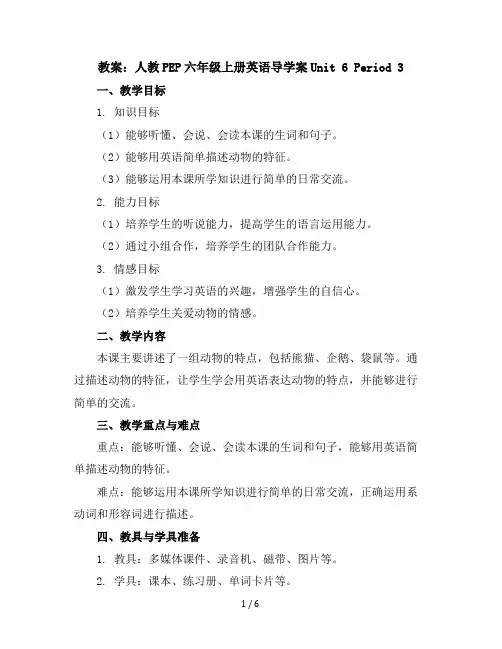
教案:人教PEP六年级上册英语导学案Unit 6 Period 3一、教学目标1. 知识目标(1)能够听懂、会说、会读本课的生词和句子。
(2)能够用英语简单描述动物的特征。
(3)能够运用本课所学知识进行简单的日常交流。
2. 能力目标(1)培养学生的听说能力,提高学生的语言运用能力。
(2)通过小组合作,培养学生的团队合作能力。
3. 情感目标(1)激发学生学习英语的兴趣,增强学生的自信心。
(2)培养学生关爱动物的情感。
二、教学内容本课主要讲述了一组动物的特点,包括熊猫、企鹅、袋鼠等。
通过描述动物的特征,让学生学会用英语表达动物的特点,并能够进行简单的交流。
三、教学重点与难点重点:能够听懂、会说、会读本课的生词和句子,能够用英语简单描述动物的特征。
难点:能够运用本课所学知识进行简单的日常交流,正确运用系动词和形容词进行描述。
四、教具与学具准备1. 教具:多媒体课件、录音机、磁带、图片等。
2. 学具:课本、练习册、单词卡片等。
五、教学过程Step 1: 热身(5分钟)1. 教师与学生用英语进行简单的交流,询问学生对本课动物的了解。
2. 学生展示自己的动物图片,并简单介绍动物的特点。
Step 2: 课堂导入(10分钟)1. 教师播放本课的录音,让学生听懂并模仿语音语调。
2. 教师引导学生跟读句子,纠正发音。
Step 3: 新课呈现(15分钟)1. 教师通过图片和实物展示,引导学生学习本课的生词和句子。
2. 学生跟读句子,教师纠正发音。
Step 4: 课堂练习(10分钟)1. 教师设计相关的练习题,让学生运用本课所学知识进行回答。
2. 学生分组进行练习,教师巡回指导。
Step 5: 小组活动(10分钟)1. 教师将学生分成小组,每组选择一种动物,用英语描述动物的特点。
2. 学生进行小组交流,教师巡回指导。
2. 学生提问,教师解答。
六、板书设计Unit 6 Period 31. 生词:熊猫、企鹅、袋鼠等。
2. 句子:My animal is a panda. It's black and white.My animal is a penguin. It's black and white.My animal is a kangaroo. It's brown.七、作业设计1. 抄写本课生词和句子。
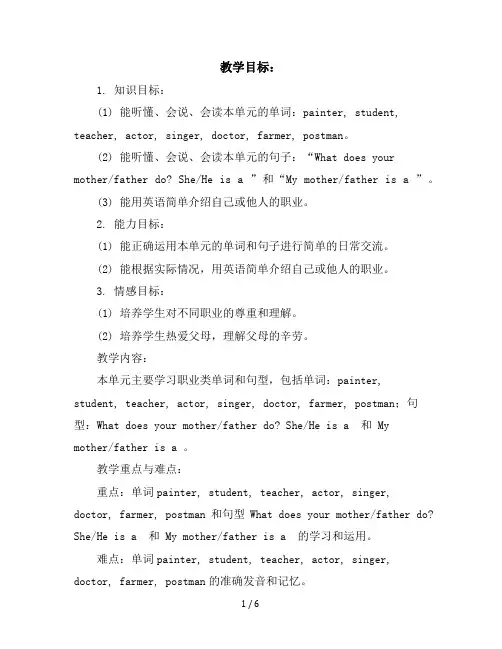
教学目标:1. 知识目标:(1) 能听懂、会说、会读本单元的单词:painter, student, teacher, actor, singer, doctor, farmer, postman。
(2) 能听懂、会说、会读本单元的句子:“What does your mother/father do? She/He is a ”和“My mother/father is a ”。
(3) 能用英语简单介绍自己或他人的职业。
2. 能力目标:(1) 能正确运用本单元的单词和句子进行简单的日常交流。
(2) 能根据实际情况,用英语简单介绍自己或他人的职业。
3. 情感目标:(1) 培养学生对不同职业的尊重和理解。
(2) 培养学生热爱父母,理解父母的辛劳。
教学内容:本单元主要学习职业类单词和句型,包括单词:painter, student, teacher, actor, singer, doctor, farmer, postman;句型:What does your mother/father do? She/He is a 和 Mymother/father is a 。
教学重点与难点:重点:单词painter, student, teacher, actor, singer, doctor, farmer, postman和句型What does your mother/father do? She/He is a 和 My mother/father is a 的学习和运用。
难点:单词painter, student, teacher, actor, singer, doctor, farmer, postman的准确发音和记忆。
教具与学具准备:1. 教具:PPT、图片、单词卡片、录音机、磁带。
2. 学具:课本、练习本、铅笔、橡皮。
教学过程:Step 1: 热身(5分钟)(1) 师生问候,进行简单的口语交流。
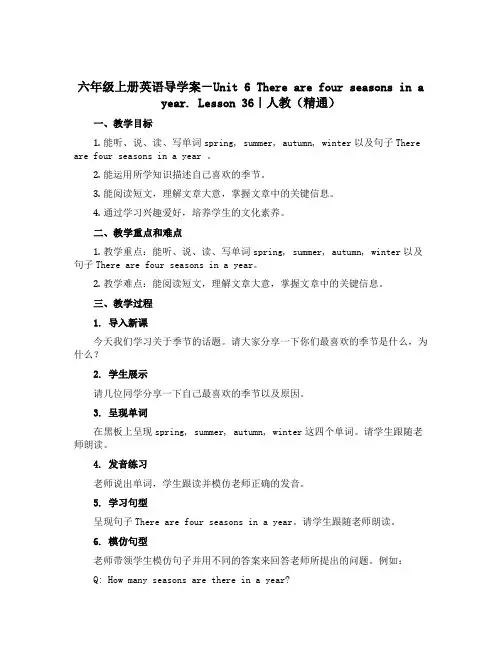
六年级上册英语导学案-Unit 6 There are four seasons in a year. Lesson 36|人教(精通)一、教学目标1.能听、说、读、写单词spring, summer, autumn, winter以及句子There are four seasons in a year 。
2.能运用所学知识描述自己喜欢的季节。
3.能阅读短文,理解文章大意,掌握文章中的关键信息。
4.通过学习兴趣爱好,培养学生的文化素养。
二、教学重点和难点1.教学重点:能听、说、读、写单词spring, summer, autumn, winter以及句子There are four seasons in a year。
2.教学难点:能阅读短文,理解文章大意,掌握文章中的关键信息。
三、教学过程1. 导入新课今天我们学习关于季节的话题。
请大家分享一下你们最喜欢的季节是什么,为什么?2. 学生展示请几位同学分享一下自己最喜欢的季节以及原因。
3. 呈现单词在黑板上呈现spring, summer, autumn, winter这四个单词。
请学生跟随老师朗读。
4. 发音练习老师说出单词,学生跟读并模仿老师正确的发音。
5. 学习句型呈现句子There are four seasons in a year。
请学生跟随老师朗读。
6. 模仿句型老师带领学生模仿句子并用不同的答案来回答老师所提出的问题。
例如:Q: How many seasons are there in a year?A: There are four seasons in a year.Q: What are the four seasons?A: The four seasons are spring, summer, autumn and winter.7. 阅读理解请学生阅读文章,并在课本上找出正确的答案。
Winter is a very cold season. It starts in December and ends in February. It often snows in winter. People can go skiing in the snow. Children can make a snowman and have snowball fights. Winter clothes are very warm. We wear a coat, a hat, gloves and boots. It’s important to keep warm in winter.1.What season is it in December, January and February?A. SpringB. SummerC. AutumnD. Winter2.What can people do in the snow?A. They can go swimming.B. They can go hiking.C. They can go skiing.D. They can go sunbathing.3.What kind of clothes do people wear in winter?A. Thin clothes.B. Small clothes.C. Warm clothes.D. Cool clothes.8. 指导学生写作请学生根据自己最喜欢的季节,写一篇50个字的短文。
六年级上册英语导学案-Unit 6 There are four seasons in ayear.Lesson 32 人教精通版一、教学目标1.能够听懂、理解并学会运用单词、短语和句型:spring, summer, autumn, winter, season, rainy, snowy, windy, sunny, hot, cool, cold, change, fall down2.能够通过听、说、读、写等渠道正确运用本课所学知识,交流谈论四季的特点及人们在不同季节里的活动;3.能够根据实际情境与语境需求用简单英语表达自己的观点,并初步形成良好的英语语感和英语思维意识。
二、教学重点1.掌握四季每个的特点及相关词语;2.学会运用本课所学知识交流谈论四季及自己在不同季节里的活动;3.学会使用一般现在时,表达当前现状和真理。
三、教学难点1.以四季为话题进行交际;2.运用一般现在时。
四、教学过程1. Warm-up1.自学词汇:season,spring,summer,autumn,winter。
2.听录音,读出四季的单词,做游戏:“四季连连看”。
2. Presentation1.学生观看课件动画,学习词汇和句型。
–What’s the weather like in spring?–It’s rainy and windy.–What can you do in summer?–I can go swimming.2.在展示原图的基础上,学生根据自己的实际情况,总结四季的特点和人们在不同季节做的事情。
3. Practice1.学生用英语描述不同季节的特点和自己在不同的季节里的活动。
2.分组讨论,对比中国和其他国家在不同季节里的不同风俗习惯,学习之外国常见习俗。
Example:- What's the weather like in spring in China?- It's warm and rainy. The trees begin to grow leaves. We can fly kites and plant trees.- How about in America?- It's sunny and cool. The flowers begin to bloom. They can go hiking an d have picnics.3.学生运用所学词汇,用英语写日记记录一天的活动,注意使用一般现在时。
教学目标1. 知识目标:(1)能够熟练运用本节课的生词和短语进行简单的日常交流。
(2)能够理解并运用本节课的主要句型进行表达。
2. 能力目标:(1)通过小组合作,提高学生的口语交流能力。
(2)培养学生独立思考和解决问题的能力。
3. 情感目标:(1)培养学生热爱生活,关注环境的意识。
(2)培养学生团结协作,积极向上的精神风貌。
教学内容1. 生词和短语:market,library,park,zoo,post office,hospital,restaurant,supermarket等。
2. 主要句型:Where is the ? It’s near 以及 How can I get to ? Take a and turn Then go教学重点与难点1. 重点:(1)掌握本节课的生词和短语。
(2)能够熟练运用主要句型进行表达。
2. 难点:(1)如何正确运用指示代词和地点状语。
(2)如何准确表达具体的路线和方向。
教具与学具准备1. 教具:PPT,地图,图片等。
2. 学具:课本,练习册,笔等。
教学过程Step 1:Leadin(5分钟)1. 教师通过PPT展示一张地图,引导学生观察并复习之前学过的地点词汇。
2. 学生自由发言,尝试用英语描述地图上的各个地点。
Step 2:Presentation(10分钟)1. 教师通过PPT展示本节课的生词和短语,引导学生跟读并记忆。
2. 教师通过PPT展示主要句型,引导学生跟读并理解。
Step 3:Practice(10分钟)1. 教师设计一系列口语练习,引导学生运用生词和短语进行交流。
2. 学生分组进行角色扮演,模拟在各个地点的对话。
Step 4:Consolidation(10分钟)1. 教师设计一个“寻宝游戏”,引导学生根据提示找出地图上的宝藏。
2. 学生分组进行游戏,同时用英语描述寻找过程中的路线和方向。
板书设计板书内容主要包括本节课的主要生词和短语,以及主要句型。
2022年《Unit 6 The story of rain》导学案温馨寄语:Art is long, but life is short. (人生有限,学问无涯。
)学习内容(Learning contents):人教版六年级上册Unit 6 Let’s start Part A Let’s learn Let's find out Let's sing Good to know学习目标(Learning aims)1.听懂、会说、正确读写单词:stream,rain,cloud,sun,vapour. (本节学习重难点)2、能够运用主要句型“Where does the rain come from?”进行询问与作答。
(本节学习重难点)3、能够完成Let's find out的任务。
4、能够听懂、会唱歌曲“Little Water Drop”。
5、了解水结成冰的相关知识。
知识链接:(Knowledge links)e from = be from 来自Where do you come from? = Where are you from?(你来自哪里?)2.把表示自然现象的名词变成形容词,来形容天气状况,如:sun-sunny;cloud-cloudy;rain-rainy;snow-snowy;wind-windy;学习指导(Learning guide)1.自主学习短语stream,rain,cloud,sun,vapour(试读,试翻译,可以借助单词表)2.听懂、会说、正确读写上面的单词(自己能背会并默写)3.根据本节学习到的知识,完成导学案。
(在自学过程中注意记录自己解决不了的问题,以便和他人合作交流)旧知复习(Revision)根据图片完成下面的填空。
What’s the weather like today?(1) (2) (3)It’s ____________. It’s ____________. It’s ____________.自主学习(Self-learning)1.水是我们生活中不可缺少的,还有什么需要水呢?观察下面的图片,写一写吧!What needs water?_Flowers,_______________________________________2.水这么重要,那水来自哪里呢?看图写写吧!Where does water come from?It comes from_______,_______,_______,______……3. 你能正确读出下面的单词吗?你能正确翻译它们的汉语意思吗?来试试吧!(自学,可借助单词表,注意划线部分的发音哦)stream ( ) rain ( ) cloud ( )sun ( ) vapour ( ) water( )4. 你能流利读出下面的句子吗?你知道它们的汉语意思吗?请写出来吧!What does the rain come from?____________________________________________________________.合作探究(Group work)1.你能正确读出下面的单词吗?大声读给你的组员听吧!听谁的发音最正确。